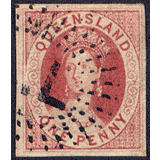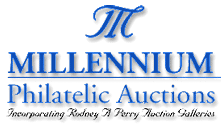|

Queensland Wednesday 21st October 2009 "...with Small and Large Chalon
Head proofs, rare singles and multiples, We are privileged to present the collection of Queensland formed by Francis Kiddle RDP Hon FRPSL. This fine collection, which concentrates on the Revenue and Railway stamps, also includes an extensive range of the Small and Large Chalons. While there are only two 1860 imperforates, both are exceptional examples (Fig. 1a) & (Fig. 1b), with the 1d being from the Ferrary, Burrus and Tomasini collections. Other exceptional pieces are possibly the finest of the few mint pairs of the 2d Wmk. Small Star perforated at Somerset House (SG 13) (Fig. 2), a mint block of 12 of the 3d Wmk. Small Star rough perf. (the equal record multiple), and a mint imperforate block of 6 of the 1868-74 6d pale apple-green, also a record multiple (Fig. 3). A used example of the 4d lilac lithograph with ‘OUR’ of ‘FOUR’ missing is a rarely-offered variety. Proofs include a block of 12 in black from plate II of the 2d annotated ‘Before Hardening 21/8/72’, and a range of colour trials for the 4d lithograph. There is also a useful range of covers. The 1881 high value lithographed Chalons include a study of the various primary types for each value, but the most impressive piece is a pen-cancelled block of 30 of the 20/- (Fig. 4). The Large Chalons begin with a range of imperforate and perforated printer’s samples, including some punctured SPECIMEN. In the issued stamps there are two fiscally used complete sheets of the £1, one on thin paper (SG 156) and the other on the thick Beer Duty paper (SG 161) (Fig. 5a) & (Fig. 5b); there is also an unused block of 20 of the latter, which is surely the largest recorded multiple, and 75 examples affixed to portion of a share transfer certificate. A cto block of 6 of the 1905-06 Wmk. Crown over Q £1 is a rarely-sighted multiple. Postal use of these stamps is scarce, but a large part 1890 cover with the 2/6d Beer Duty paper and 2/- Sideface, although addressed to a well-known philatelic address in Melbourne, seems to be a genuine usage. In the Stamp Duty adhesives subsequently authorised for postal use, the Kiddle Collection contains many important pieces. Amongst proofs of the 1866-68 lithographs are examples of the unissued 3/- and 7/-. A fine mint block of 16 the 1d Wmk. Crown over Q must be very scarce, and there is an equally fine mint 5/- yellow. The only postal usage on cover is a 1d with a 1d Sideface pair to Sydney in 1885. The 1871-72 series is prefaced by an unadopted printed essay in red for the 1d denomination (Fig. 6). There is a range of proofs of this series, both imperforate and perforated, the most interesting being a rare 1d block of 4 in orange-yellow printed from a matrix block with differences to the issued stamp. The issued stamps include the 6d in a postally used horizontal pair imperforate vertically (uncatalogued) (Fig. 7), and usage on 1886 cover to England. The 2/- Wmk. Crown over Q is represented by a rare mint block of 4, and a fiscally used vertical pair imperforate horizontally (Fig. 8). The 1878 small 1d Stamp Duty includes imperforate proofs, and a rare strip of 6 used on an 1880 cover to England. The 1892 long Stamp Duties include little postal usage, but there is a good range of proofs and Specimens. The King Edward VII adhesive Stamp Duties are highlighted by corner blocks of the 1d and 2d demonstrating the monogram design used to fill the final unit of the sheet (Fig. 9a) & (Fig. 9b). Turning to the adhesive stamps issued purely for revenue purposes, the collection is strong in all issues up to decimal currency, with proof material through all the issues. There are 23 lots of Beer Duty stamps, generally in well above average condition. One of the most attractive items is a die proof in black of an unaccepted design for the 1897 12/9d stamp (Fig. 10). The scarce Commissioner’s Adjudication adhesive is represented by a mint block of 10, and an example used on a 1900 document. The Impressed Duty adhesives form an important group. The Queen Victoria series from 3d to £500 is one of the better known revenue issues, but most of these are in the form of presentation sets with colourless relief embossing or cto cancellations. The Kiddle Collection includes a selection of 33 denominations between 3d and £500 in mint blocks of 4. There are also three composite die proofs of the 17/6d and £500 with unadopted value tablets. The King Edward VII issue has a series of 30 plate proofs in black between 3d and £5. A very interesting set of five sheets inscribed ‘IMPRESSED DENOTING STAMPS’ from c1920 shows the set of current Impressed Duty adhesives from 3d to £1000 handstamped SPECIMEN in red, affixed and tied by embossed handstamps (Fig. 11). The stamps are a mixture of QV, KEVII and KGV types, indicating the reason certain denominations do not appear in the later series. The 1930-60 numeral series is highlighted by examples of the very rare ultra-high value £5000 both mint (Fig. 12) and used on piece. All the other revenue series - Adhesive Duty, Buffalo Fly Control, Commodities Levy, Producers Association, State Development, Swine Sales, Unemployment Insurance, and Unemployment Relief Tax - are well represented with proofs, issued stamps, and documents. The Queensland Railway Stamps are similarly impressive. The 1872 first issue comprises the 1/- blue as an imperforate proof (Fig. 13a) and two used examples, the 2/- imperforate proofs in black (Fig. 13b) and rose, a perforated proof in black, and a possible unused example of the issued stamp. There are ten examples of the even rarer c1880 typeset stamps, plus an example of the 6d used on a parcel front that has survived because the front was turned and used to post a package to England; this is believed to be unique (Fig. 14). The later railway issues include proofs and specimens, and a study of various roulettes and perforations used. There are three die proofs for a proposed ‘Lay By to Travel’ issue from c1940 (Fig. 15), and the Cairns-Mulgrave private issue is represented by mint and used sets. Overall, the range of Queensland Revenue and Railway stamps is the finest and most extensive ever to be offered at auction, and will attract great interest from the ever-increasing number of revenue collectors. |

